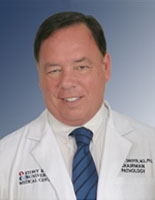03 Sep Protein Keratin Promotes Cancer Growth and Chemotherapy Resistance
MedicalResearch.com Interview with:
Kenneth R. Shroyer, MD, PhD
The Marvin Kuschner Professor and Chair
Department of Pathology
Stony Brook Medicine
Stony Brook, NY
Medical Research: What is the background for this study? What are the main findings?
Dr. Shroyer: Patients that appear to have the same type of cancer often respond very differently to treatment; while some patients appear to go into long-term regression or are cured, others follow a rapid downhill course and ultimately die of their disease. This suggests that there are fundamental differences between tumors at the biologic level that are not detected by current clinical measures.
In this study, we report the unexpected finding that cancer patients that have high levels of a protein called Keratin 17 (K17) have decreased long-term survival when compared to patients that express little to no K17 in their tumors. In addition, we found that K17 enters the nucleus of tumor cells to mediate the degradation of the master regulator of cell division and tumor growth key tumor suppressor protein, p27. Furthermore, we identified that K17 increases the resistance of tumor cells to chemotherapy.
These are critical findings because this is the first report that a keratin is an oncoprotein that can enter the nucleus to promote the development of cancer and resistance to chemotherapy.
Medical Research: What should clinicians and patients take away from your report?
Dr. Shroyer: Overall, these results suggest that K17 could be used as a biomarker to distinguish between “clinically identical” patients, identifying cases that are more aggressive at the time of diagnosis and potentially guiding personalized treatment based on individual K17 status.
Medical Research: What recommendations do you have for future research as a result of this study?
Dr. Shroyer: These findings provide insight into why cancer patients without K17 expression have better survival probability compared to patients that have high K17 levels. Further studies, however, are needed to determine if there are additional roles of K17 in cancer that extend far beyond its effect on p27. In addition, it is still not known why some patients express K17 and others don’t; understanding what triggers K17 expression could one day help us to elucidate more effective ways to treat cancer patients by targeting K17 expression and to potentially increase the survival of patients with cancer.
Citation:
Keratin-17 Promotes p27KIP1 Nuclear Export and Degradation and Offers Potential Prognostic Utility
Cancer Res Published OnlineFirst June 24, 2015; doi:10.1158/0008-5472.CAN-15-0293
[wysija_form id=”5″]
MedicalResearch.com is not a forum for the exchange of personal medical information, advice or the promotion of self-destructive behavior (e.g., eating disorders, suicide). While you may freely discuss your troubles, you should not look to the Website for information or advice on such topics. Instead, we recommend that you talk in person with a trusted medical professional.
The information on MedicalResearch.com is provided for educational purposes only, and is in no way intended to diagnose, cure, or treat any medical or other condition. Always seek the advice of your physician or other qualified health and ask your doctor any questions you may have regarding a medical condition. In addition to all other limitations and disclaimers in this agreement, service provider and its third party providers disclaim any liability or loss in connection with the content provided on this website.
Kenneth R. Shroyer, MD, PhD (2015). Protein Keratin Promotes Cancer Growth and Chemotherapy Resistance MedicalResearch.com
Last Updated on September 3, 2015 by Marie Benz MD FAAD

